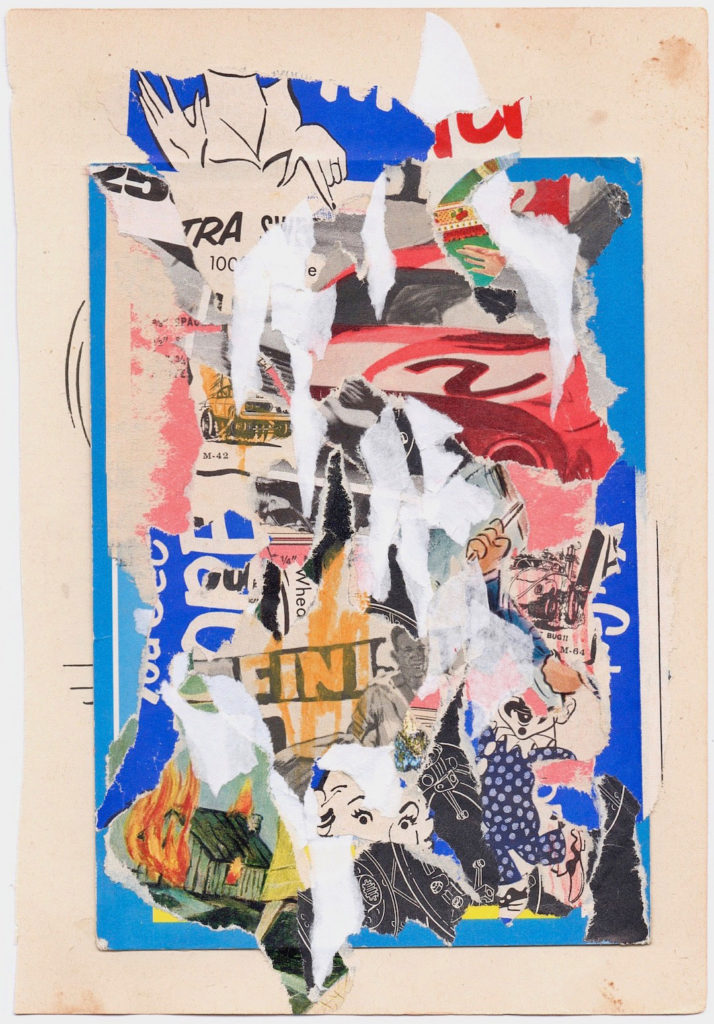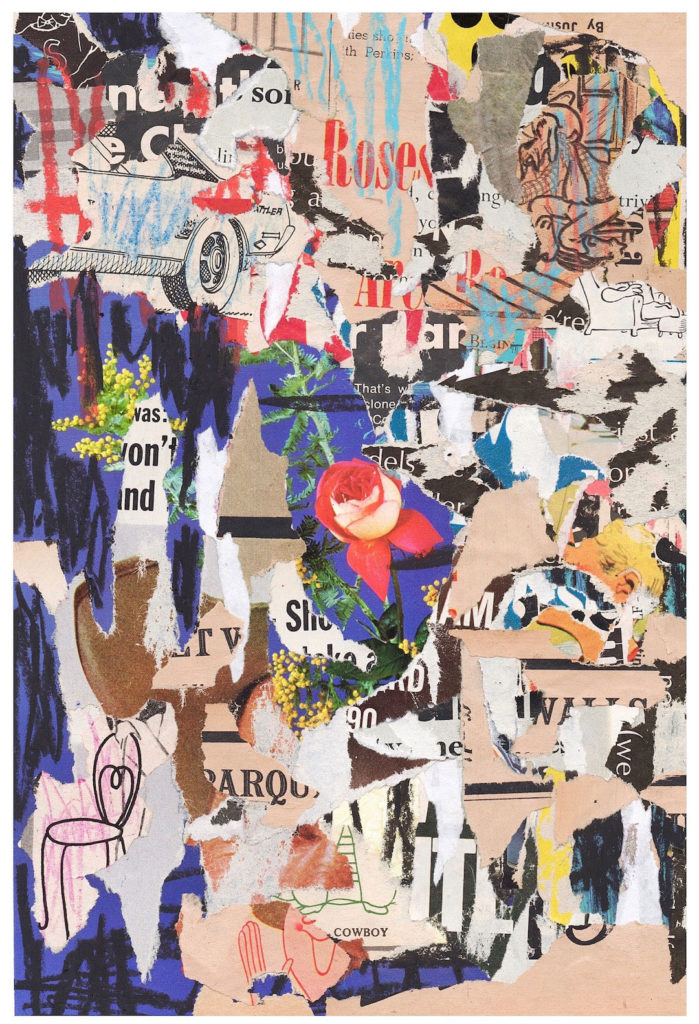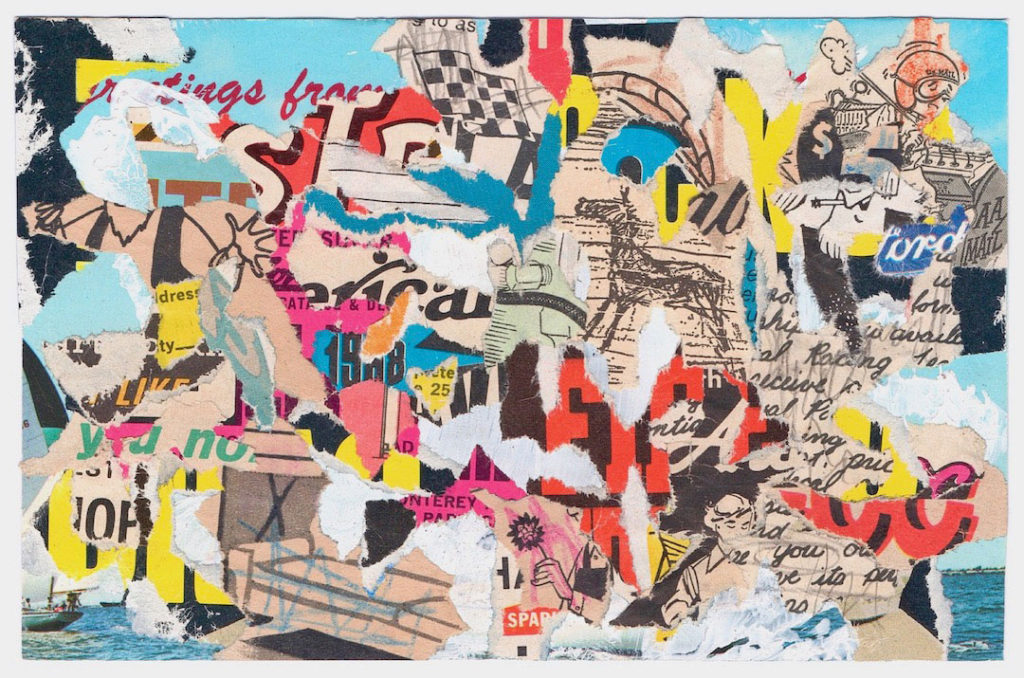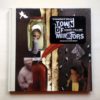Hey Adam, can you tell us a bit about yourself?
Hey there, I am Adam Brierley an artist living Orange, CA. When I am not working I dedicate most of my time to my art, vintage clothing, antique shops, record stores, coffee and hanging with my girlfriend and my brother.
Your work addresses collage in very visceral way. There’s a lot of tearing paper, maniac doodling, raw compositions, etc. It seems that you have a very physical relationship with the media you process. Can you comment about this and about your work process?
Thats great that comes across in my work. That is exactly the way I feel about my pieces when I am in the process of creating them. Lots of ripping, tearing and scribbling.
My process, I usually will put on some good music, whatever I am feeling in that moment, grab my bins of paper scraps and just go with my gut. I never really plan out a piece, I just try to let everything come naturally. I will literally just sit and dig through scraps of paper or flip through some vintage magazines for hours until I see a piece that catches my eye. It could be anything really – text, colors, shapes, doodles anything that stands out to me in that moment and I will rip out and glue down. Then usually I will scribble all over it and cover it with more scraps of paper. Then rip half of it off, paint on it and scribble over it again.
To me, the scribbles / marks add a nice texture. I want my work to feel a bit chaotic and all over the place, I see it as an organized mess. I want people to look at my work and think “what the hell am I looking at” then take a closer look and find small elements that stand out to them. At first glance it could be a cowboy, or a shape, then you look closer and you see an old car, a hand or some text. I feel doing it that way really lets my current mindset dictate how it comes together and when I feel it is complete.
Most of your artworks are made with small bits and pieces where the original image is almost impossible to be recognized. Which role has the selection of source images in your work process? and, what do you aim to do with this hyper-fragmentation of your source images?
Most of my source material I try to physically hunt down myself. Where I live there are a few great antique shops I walk to every week. I am always on the hunt for a vintage magazines, books, posters, postcards. All these old materials have a different feeling, texture, color tint. It’s hard to replicate naturally aged paper, it tears different and looks different when you glue it down. I like the idea of taking something old that already exist and reusing it to create something new. I also buy some source material on eBay or Etsy, but I like the physical hunt the most.
My main goal with the hyper-fragmentation is to create layers of texture. I try to create pieces that make you concentrate and find scraps or details that stand out to you (the viewer). Every scrap, tear, scribble is intentional and I find it interesting to see what stands out to people the most. Everyone has a different eye.
You use lots cut out words in your collages where you can see fragments of the letters, but you can’t access to the meaning of those words. Which is the place of text in your artworks?
Text is just another element of layering for me. But I am very picky when it comes to the text I use. I don’t really pick out specific words, I look at them more for their shape, color and how that will fit into the piece I am working on.
How do you use it as a way to create meaning without showing the actual words?
Each piece means something to me, but I like the idea of leaving it up to the viewer to decide what role the word or text play in the piece. I don’t want to tell people how to feel so I keep the words a bit hidden or just use a fragment of a word because I want people to create their own meaning.

Even I find your art extremely personal, I can see in your work traces of different art movements: abstract expressionism, ultra-letterism (Mimmo Rotella), pop art.
Four years ago my style of collage was completely different than what it is today. I think when you start its important to try out a bunch of different techniques to figure out what feels natural and fits you best. I feel I have found what works best for me and have created my own method / style of working. But I couldn’t have done that without exploring many other methods of collage first.
Some of my favorite artist are not even collage artist. I think the idea of constantly putting your work out in the world and consistently executing something that you personally believe in has shaped my way of working the most. It’s that mindset that lets you create in your own headspace and not care what anyone else thinks.
Which artists had been important in your development and have informed your way of making art?
Here are some of my favorite artist – Matt McCormick, Fred Free, Matt Maust, Robert Nava, Julian Klincewicz, B.D. Graft, Brian Harte, Anthony Zinonos, Timber Charter, Dean Coward and my brother Keith Brierley.
I definitely pull a lot of inspiration from my surroundings as well. I work in downtown Los Angeles during the week and just walking around seeing the walls of wheat-paste advertisements / layers of torn posters and paper has really shaped the way I create. Thats how I want my art to look, but in my own way.
What do you think of seeing your work as a collage of styles too?
I feel like you could definitely say that about my work. There is usually a lot going on in a piece.
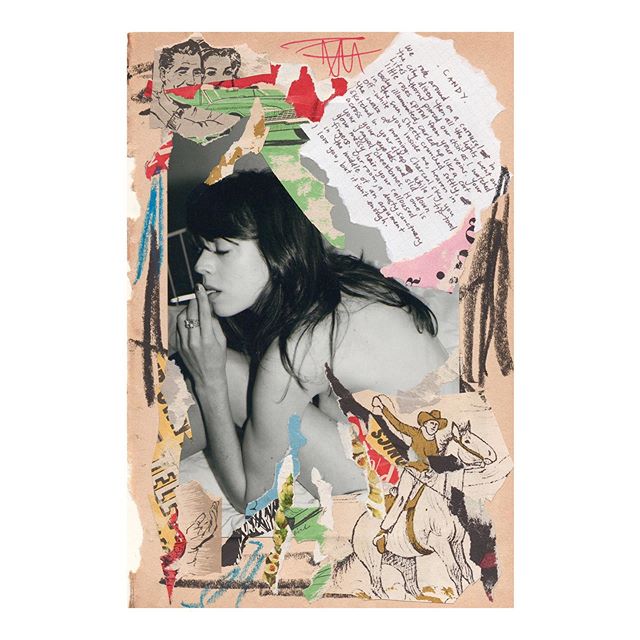
You have recently collaborated with photographer and poet Jenna Putnam. Can you tell us a bit about this collaboration.
Jenna and I had been chatting on instagram about working on something together. Once we figured out what we wanted to do she mailed me some of her original photo prints and poems and from there I created a series with details that I felt fit the images best. It actually took me a few months to source the materials I wanted to use for this project. Each piece has a cowboy or western reference that ties it together and finding old western books was a bit of a hunt. But it turned out exactly how I wanted!
When there’s no re-appropiation of random images but a collaboration with a photographer, how does that affect your attitude towards modifying and working with the images?
It doesn’t change much, If anything it makes me think a bit more about how I am going to tie the series of images together to feel cohesive.
Have you have a different approach towards collage in that situation?
I think collaborative projects create a different way of working. I still apply the same method I normally would, but when creating with another persons material it gives me more of a clear starting point and boundaries to work in.
What’s your definition of collage?
An organized mess.
Check Adam’s latest works here!



